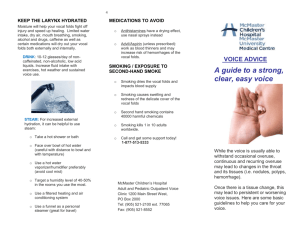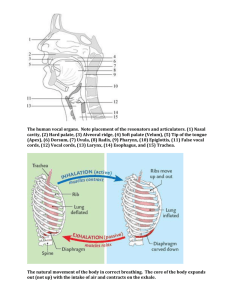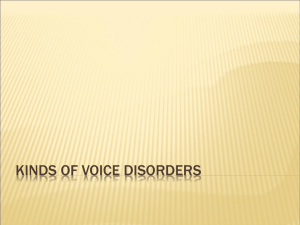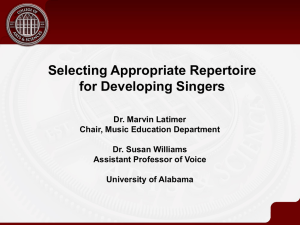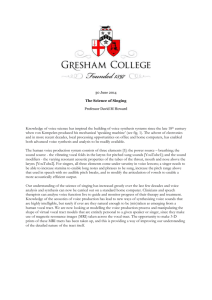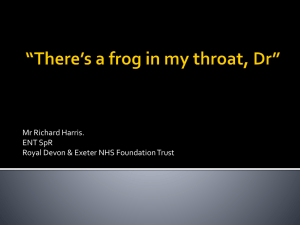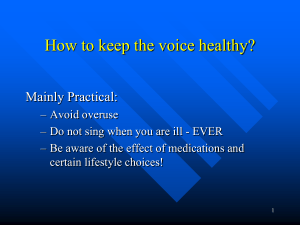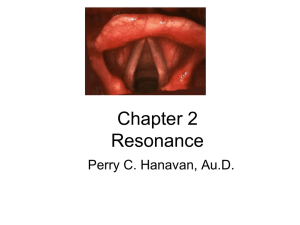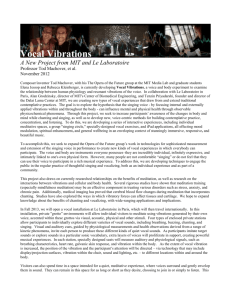Care For Your Voice!
advertisement
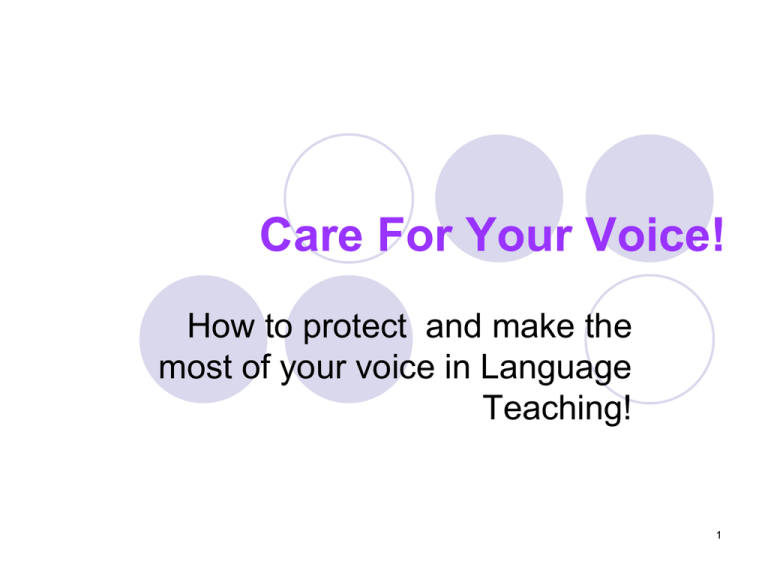
Care For Your Voice! How to protect and make the most of your voice in Language Teaching! 1 TALK, Chatter, gossip, Everyone All things to all people All day long, every day Whether you feel like it or not!! Amounting to a lot of…. 2 VOICE WORK! 3 Common Vocal Challenges in LanguageTeaching Variety of interactions Problem spaces Challenging situations Learners’ needs The need to keep on top of everything Very little voice training 4 FUNDAMENTAL RESOURCE Healthy Over worked Flexible Neglected Protected Abused 5 Poor reception by student! Lack of clarity Weak carrying power Restricted vocal variety Reduced tonal quality 6 PERSONAL STRESS!!!!!!!!!! Leading to.. FATIGUE EXHAUSTION COLLAPSE 7 How stress affects the voice Difficulty swallowing Aching neck Backache & muscle tension Fatigue Frequent urination & diarrhoea Immune system reduced Indigestion Clarity problems 8 PROFESSIONAL STRESS!!!!!!!!!! Leading to.. Over preparation and over work Lack of effectiveness Confidence problems 9 Left unchecked this can lead to.. Vocal strain Vocal problems Voice Loss 10 The Vocal Tract 11 What do vocal folds look like? BREATHING SPEAKING Vocal Cords are Open Vocal cords close and vibrate 12 Vocal Folds Opening and Closing 13 Many Times! Men 110 Cycles/Second (Hz) Women 180-220 Cycles/Second Children 300 Cycles/Second LOWER PITCH MEDIUM PITCH HIGH PITCH 14 Vocal Cord Nodules 15 DRINK TO YOUR HEALTH! Keep the vocal folds moist! Sip of water for ever 15 – 20 mins speaking!! Rest whenever possible!!! 16 For clear speech we need…….. Power + Vibration + Resonance and ARTICULATION! 17 Understanding Clarity Intent Focus 18 Posture - make an entrance! Are you in control? Are you relaxed? Ready for action? What are my bad habits?! 19 POSTURE POINTS Open Balanced Free unrestricted 20 Vocal Restriction? Slumped Restricted Depressed 21 Prepare the body for speech Stretching Moving Opening the chest Relaxing the shoulders,head and neck Jaws! Face 22 BE PREPARED! Warm up! Tune in!! Calm down!! 23 BEFORE YOU BEGIN Unrestricted clothing Drop the heavy clutter Free the body – free the voice! 24 - A warmed voice means warm tones! Yawn with an ah to open the throat Breathe out to a ‘sh; Hum up and down a scale Me ma mo may me Many men, many men etc All I want is a proper cup of coffee made in a proper copper coffee pot . 25 Are my breaths big enough?! Freeing the voice Big Sound/volume Balancing our thinking Breath for speech Breath for Life! 26 Easy Breathing Sit with back to chair elbows on knees, chin on hands – breathe in Breath and out on fff, vvvv, zzzzz Stand in star position, breathe out on an s, as you do bend over to touch floor(allow knees to bend) pause until you feel the need to breathe. Say the months of the year (in English or Welsh) on one even breath! 27 Work those consonants Where do you perceive the consonants are formed? Which articulators are connecting? Both lips? Top teeth and bottom lip? Tongue and teeth? Tongue to gum ridge? Tongue to hard palate? Back of tongue to soft palate??? 28 Consonants Clocks ticking, ticking clocks, tick tock, Five from four fives leaves fifteen Charlie chose hunky chicken chips ‘K’ kkkkk, ‘g’ggggg ‘p’ppppp bbbbb ‘t’tttt ‘d’dddd 29 Place and use your vowels Where are they formed? Long or short? Carrying power? 30 Vowels as/oo/ay/or/ah make the vowels last as long as you can Ah – chest resonance W – mouth resonance Eat up Arthur I urge you! The five parked cars are mine Ahoy there, Ahoy 31 Be clear! Be Heard! Be Effective! Consonants for: •Clarity •Audibility •Impact (clout!) Vowels •Warmth •Mood •Meaning What do need to say? How do I want to say it?? 32 Establish your vocal territory Fix the state of mind Establish control Find breath, tone, focus 33 How do you sound?! Wobbly Tight Nasal High pitched Monotonous Robotic Uncomfortable? Change your tune Match your ‘music’ to the message 34 And your tone? This is an interesting topic? You’re going to enjoy this I’m so lucky to be doing this It’s so lovely to see you all 35 Muscularity Energy in words Vitality of voice Power rather than projection! 36 Vocal Variety – Increase your Personal Presence Pitch Pace Pause Pronunciation Power 37 Relax, Breathe and articulate the following “Oh! But he was a tight-fisted, hand at the grindstone, Scrooge! A Squeezing, wrenching, grasping, scraping, clutching, covetous old sinner! Hard and sharp as flint, from which no spark had ever struck out generous fire; secret and selfcontained as an oyster.” From A Christmas Carol by Charles Dickens 38 What must I do to make it easier? Breath support Warm ups Effort away from throat!! Anchoring when having to speak loudly Avoid shouting/clearing the throat Not competing with background noise Devising other methods of calling attention Sips of water Relaxed body – safeguarding posture 39 Each Day Keep a check on Posture Breathing Relaxation Articulation Reduce lecturer talking time Increase volume through resonance Use face and gesture, non verbal communication! 40 Problems and Warning Signs Breaks in the voice Changes in pitch or volume Changes in vocal quality Changes in the body Increased effort Recurring loss of voice Sensation of ‘lump in the throat’ 41 DANGER! Talking or singing at a high or artificially reduced volume levels Talking or singing with cramped neck position, distorted laryngeal position, a clenched jaw, inadequate or excessive mouth opening Throat clearing or coughing Shouting, screaming or yelling Talking or singing with insufficient air 42 AVOID! Keeping larynx too high in the neck or using too high or low a pitch level. Talking or singing for too long Trying to be heard over the top of other speakers or background noise. Making noises, imitating animal sounds, TV characters.(small children) Tryng to over-compensate for a vocal problem, thereby altering muscle position and tone. 43 Home Help Reduce voice use Increase hydration, reduce alcohol, cigarettes Voice and body rest Keep larynx and vocal tract moist – steam the back of the throat Gargle with salty water Always warm the voice before use Avoid medicated throat pastilles that kill pain 44 Seeking medical help Go to GP Referral to ENT ENT takes case history and visualises larynx with endoscope or laryngeal mirror If nothing sinister, refer to SLT for further assessment & advice Individual or group therapy as necessary Voice clinic 45

